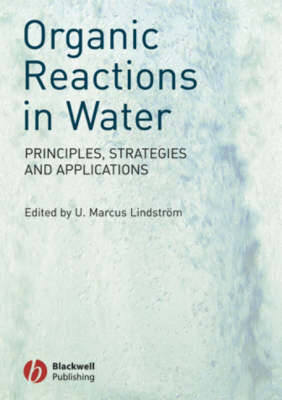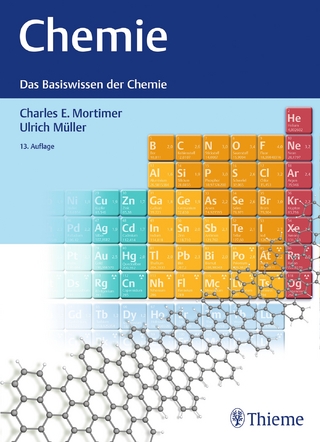
Organic Reactions in Water
Wiley-Blackwell (Verlag)
978-1-4051-3890-1 (ISBN)
Marcus Lindström has recently joined the faculty of the Department of Chemistry, McGill University, Canada as Assistant Professor of Organic Chemistry. Prior to his move to Canada he was Associate Professor of Chemistry at Lund University, Sweden. Contributors to the book: Professor Ronald Breslow Dr Jan B. F. N. Engberts Dr Shu Kobayashi Dr Chikako Ogawa Dr Chao-Jun Li Dr Francesco Fringuelli Dr Oriana Piermatti Dr Ferdinando Pizzo Dr Luigi Vaccaro Professor T. V. RajanBabu Dr Seunghoon Shin Dr Roger Sheldon Dr Denis Sinou Professor Charles L. Liotta Professor C A Eckert Dr J.P. Hallett Dr Pamela Pollet Dr Kaoru Nakamura Dr Tomoko Matsuda Professor K. Barry Sharpless Dr Sridhar Narayan Dr Valery V. Fokin Professor Boy Cornils Dr Ernst Wiebus
1. A Fifty Year Perspective on Chemistry in Water (R. Breslow). 1.1 Enzyme mimics and models.
1.1.1 Thiamine.
1.1.2 Cyclodextrins.
1.1.3 Cyclodextrins with bound metal ions.
1.1.4 Cyclodextrin dimers.
1.1.5 Ribonuclease mimics.
1.1.6 Transaminase mimics.
1.1.7 Cytochrome P-450 mimics.
1.2 Reactions in Water Promoted by Hydrophobic Binding of Small Molecules.
1.2.1 Diels-Alder reactions.
1.2.2 The benzoin condensation.
1.2.3 Atom transfer reactions.
1.3 Quantitative Antihydrophobic Effects in Water, and the Geometries of Transition States.
1.4 The Importance of Water as a Reaction Solvent.
2. Structure and Properties of Water (J. B. F. N. Engberts).
2.1 Water. The molecule and the liquid.
2.1.1 The single water molecule.
2.1.2 Liquid water.
2.2 Properties of water.
2.2.1 Solvent properties and parameters.
2.2.2 Thermodynamics of hydration.
2.2.3 Hydrophobic interactions.
2.3 Kinetic solvent effects in aqueous solutions.
3. Acid Catalysis in Water (C. Ogawa and S. Kobayashi).
3.1 Homogeneous catalysis.
3.1.1 Brønsted acid catalysis.
3.1.2 Lewis acid catalysis.
3.1.3 Asymmetric catalysis.
3.2 Heterogeneous catalysis.
3.2.1 Polymer-supported Brønsted catalysis.
3.2.2 Polymer-supported metal catalysis.
3.3 Micellar catalysis.
3.3.1 LASC (Lewis acid-surfactant combined catalyst).
3.3.2 BASC (Brønsted acid-surfactant combined-catalyst).
3.4 Conclusion.
4. Metal-Mediated C-C Bond Formations in Aqueous Media (C-J. Li).
4.1 Reactivity of organometallic compounds with water.
4.1.1 Carbon-metal bonding.
4.1.2 Carbon-metal hydrolysis.
4.1.3 Carbon-metal reactions.
4.1.4 C-C bond formations via carbon-metal reactions in water.
4.2 Allylation of carbonyls and imines.
4.2.1 Allylation of carbonyl compounds.
4.2.2 Allylation of imines and related compounds.
4.3 Propargylation/allenylation of carbonyls, imines and related compounds.
4.4 Metal-mediated benzylation of carbonyls and imines.
4.5 Arylation and vinylation of carbonyls and imines.
4.5.1 Arylation and vinylation of aldehydes.
4.5.2 Arylation and vinylation of imines.
4.6 Alkynylation of carbonyls, imines, and related compounds.
4.6.1 Alkynylation of aldehyde.
4.6.2 Alkynylation of imines and related compunds.
4.6.3 Asymmetric alkynylation.
4.7 Metal-mediated aldol and Reformatsky-type reactions.
4.8 Metal-mediated alkylation of carbonyls and imines.
4.8.1 Alkylation of carbonyls.
4.8.2 Alkylation of imines.
4.9 Metal-mediated conjugate addition reactions.
4.9.1 Addition of alkyl groups.
4.9.2 Addition of vinyl and aryl groups.
4.9.3 Addition of alkynes.
4.10 Metal-mediated coupling reactions.
4.10.1 Pinacol coupling.
4.10.2 Other reductive couplings.
4.10.3 Cross-Dehydrogenative-Coupling.
4.11 Conclusions.
4.12 Acknowledgements.
5. Pericyclic Reactions in Aqueous Media (F. Fringuelli, O. Piermatti, F. Pizzo, L. Vaccaro).
5.1 Diels-Alder Cycloaddition Reactions.
5.1.1 Carbo Diels-Alder Reactions.
5.1.2 Biocatalyzed Carbo Diels-Alder Reactions.
5.1.3 Hetero Diels-Alder Reactions.
5.1.4 The Role of Water.
5.2 1,3-Dipolar Cycloaddition Reactions.
5.2.1 Pyrrole and Pyrrolidine-Ring Formation.
5.2.2 Isoxazole and Hydroderivatives-Ring Formation.
5.2.3 Pyrazole and Pyrazoline-Ring Formation.
5.2.4 Triazole and Triazoline-Ring Formation.
5.2.5 Tetrazole-Ring Formation.
5.3 [2+2] Photo-Cycloaddition Reactions.
5.4 Claisen Rearrangement Reactions.
6. Catalyzed Reductions in Aqueous Media (T. V. RajanBabu and S. Shin).
6.1. Special features of hydrogenation in water mediated by organometallic catalysts.
6.2. Water-soluble complexes for aqueous hydrogenation.
6.2.1. Sulfonated phosphine and other ligands.
6.2.2. Nitrogen-containing phosphine ligands.
6.2.3. Hydroxyphosphines and other oxygen-containing ligands.
6.3. Hydrogenation of C=C bond.
6.3.1. Reductions of dehydroamino acid and acrylic acid derivatives.
6.4. Hydrogenation of C=O bond.
6.4.1. Chemoselectivity of C=C vs. C=O bonds.
6.5. Asymmetric reduction of C=O bond in water.
6.5.1. Asymmetric hydrogenation of C=O bond in water.
6.5.2. Asymmetric transfer hydrogenation of C=O bond in water.
6.5.3. Hydrogenation of C=N bond.
6.6. Miscellaneous reductions. Reduction of epoxides, halides and carbon dioxide.
6.7. Summary and outlook.
.
7. Oxidations (Roger A. Sheldon).
7.1 Water-soluble ligands.
7.2 Oxidations catalyzed by metalloporphyrins and metallophthalocyanines.
7.3 Epoxidation and dihydroxylation of olefins in aqueous media.
7.4 Alcohol oxidations in aqueous media.
7.5 Aldehyde and ketone oxidations in water.
7.6 Sulfoxidations in water.
7.7 Concluding remarks.
.
8. Nucleophilic Additions and Substitutions in Water (D. Sinou).
8.1 Nucleophilic Additions.
8.1.1 The Aldol Reaction.
8.1.2 Michael Addition.
8.1.3 Mannich-Type Reaction.
8.2 Nucleophilic Substitution.
8.2.1 Ring-opening nucleophilic substitution.
8.2.2 Alkylation Reactions.
8.2.3 Other types of substitutions.
8.3 Conclusion.
9. Reactions in Nearcritical Water (C.L. Liotta, J.P. Hallett, P. Pollet, C.A. Eckert).
9.1 Characterization of Nearcritical Water.
9.1.1 Physical and Thermodynamic Properties of Nearcritical Water.
9.1.2 Solvatochromic Characterization of Nearcritical Water.
9.2 Reactions in Nearcritical Water.
9.2.1 Hydrolysis of Ester and Ether.
9.2.2 Hydrolysis of Nitriles.
9.2.3 Hydration of-pinene.
9.2.4 Elimination Reactions.
9.2.5 Friedel-Crafts Alkylation Reactions.
9.2.6 Friedel-Crafts Acylation Reactions.
9.2.7 Condensation Reactions.
9.2.8 Rearrangements.
9.2.9 Hydrogen/Deuterium Exchange.
9.2.10 General Acid Base Reactions.
9.3 Reactions in High Temperature Water Enriched with CO2.
9.4 Limitations & Safety.
9.5 Conclusion.
10. Biocatalysis in Water (K. Nakamura, T. Matsuda).
10.1 Basic aspects of biocatalysis.
10.1.1 Reaction classification.
10.1.2 Kinetics of enzymatic reactions.
10.1.3 Reaction mechanism.
10.1.4 Selectivities.
10.1.5 Experimental conditions.
10.2 Reduction.
10.2.1 Stereochemistry of hydride transfer.
10.2.2 Baker’s yeast catalyzed reaction.
10.2.3 Overexpression of key reductases from baker’s yeast in E. coli.
10.2.4 Asymmetric reduction by Geotrichum candidum.
10.2.5 Hydrogen sources.
10.2.6 Reduction of carbon-carbon double bonds.
10.2.7 Reduction of hydroperoxides.
10.2.8 Reduction of sulfoxides.
10.3 Oxidation.
10.3.1 Oxidation of alcohols.
10.3.2 Hydroxylation.
10.3.3 Baeyer-Villiger oxidations.
10.3.4 Oxidation of sulfur compounds.
10.3.5 Oxidative polymerization.
10.4 Hydrolysis of esters.
10.4.1 E-value.
10.4.2 Synthesis of chiral compounds by enzymatic hydrolysis of esters.
10.4.3 Hydrolysis of sterically hindered esters.
10.4.4 Hydrolysis of esters with fluorine functionalities.
10.4.5 Methods of controlling reactivity and enantioselectivity.
10.4.6 Control of reactivity and enantioselectivity by genetic engineering.
10.4.7 Hollow-Fiber membrane reactor for lipase catalyzed hydrolysis: synthesis of Diltiazem.
10.4.8 Lipase catalyzed optical resolution coupled with in situ inversion: synthesis of Prallethrin (pyrethroid) etc.
10.4.9 Recognition of fluorinated functionalities from unfluorinated group: H vs. F.
10.4.10 P-chiral and S-chiral compounds.
10.5 Other types of hydrolysis, dehydration and halogenation.
10.5.1 Hydrolysis of expoxides.
10.5.2 Hydrolysis of amide and nitrile.
10.5.3 Dehydration in water for the synthesis of nitriles.
10.5.4 Desulfonation.
10.5.5 Direct glycosylation.
10.5.6 Dehalogenation.
10.5.7 Fluorination.
10.6 C-C bond formations.
10.6.1 Aldol reactions.
10.6.2 Cyanohydrin synthesis.
10.6.3 Carboxylations.
10.7 Dynamic kinetic resolution.
10.7.1 Dynamic kinetic resolution of racemic ketones through asymmetric reduction.
10.7.2 Dynamic kinetic resolution using hydrolytic enzymes.
10.7.3 Deracemization.
10.8 Conclusion.
11. Chemistry ‘On Water’ – Organic Synthesis in Aqueous Suspension (S. Narayan, V. V. Fokin, K. B. Sharpless).
11.1 Background.
11.2 The Unique Reactivity of Azodicarboxylates on Water.
11.3 Other Examples from Our Work.
11.4 Applications of the ‘On Water’ Method.
11.5 Perspective and Conclusion.
12. Water as a Reaction Solvent - an Industry Perspective (Ernst Wiebus, Boy Cornils).
12.1 Hydroformylation as the Master Development.
12.1.1 General.
12.1.2 Immobilization with the Help of Liquid Supports.
12.1.3 Principles.
12.2 Examples of Aqueous Phase Catalyses.
12.2.1 Hydroformylation (Ruhrchemie/Rhône-Poulenc[RCH/RP] process).
12.2.2 Other Industrially Used Aqueous-biphasic Processes.
12.2.3 Short Overview of other (Lab scale) Reactions.
12.3 The "Aqueous" Recycle and Recovery of Biphasic Catalysts.
12.3.1 Recycle.
12.3.2 Recovery.
12.4 Economics of the Process.
12.5 Environmental Aspects.
12.6 Concluding remarks.
| Erscheint lt. Verlag | 4.4.2007 |
|---|---|
| Verlagsort | Hoboken |
| Sprache | englisch |
| Maße | 175 x 246 mm |
| Gewicht | 1066 g |
| Themenwelt | Naturwissenschaften ► Chemie ► Organische Chemie |
| ISBN-10 | 1-4051-3890-4 / 1405138904 |
| ISBN-13 | 978-1-4051-3890-1 / 9781405138901 |
| Zustand | Neuware |
| Haben Sie eine Frage zum Produkt? |
aus dem Bereich


